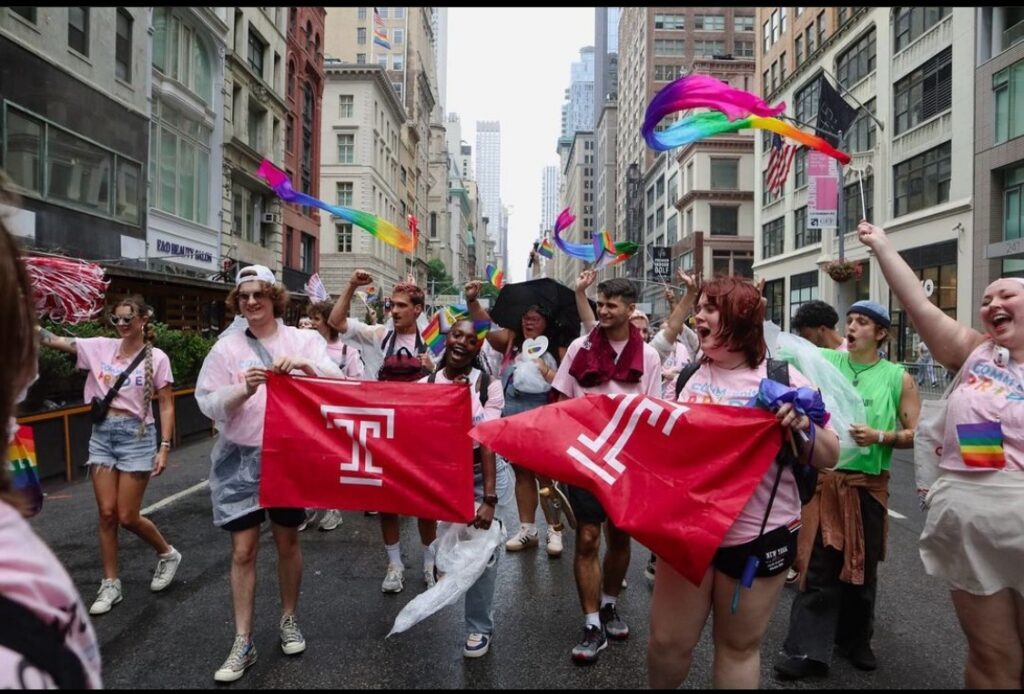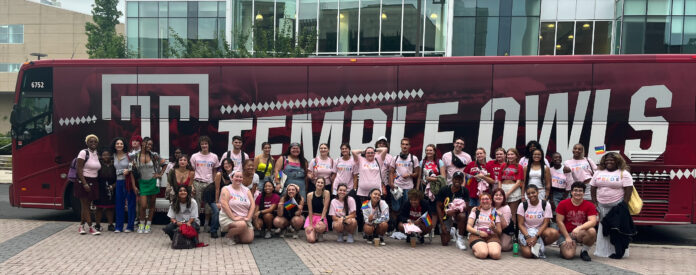“[Young people] are already taking over the reins — and that to me is incredibly powerful,” said Scott Gratson, Temple University’s director of undergraduate studies in the School of Media and Communication.
Gratson founded the school’s “NYC Study Away” program, where students learned about LGBTQ+ history, and then got to be involved in planning and implementing New York City’s Pride march.
“That, to me, is the definition of Pride — to realize that the movement is in safe hands and will eventually achieve the goals that we set decades ago.”
Gratson, who called himself a survivor of the AIDS pandemic, said the only conversations he had about LGBTQ+ experiences during his own undergraduate studies was in debates during psychology courses about whether or not to declassify aspects of queer identity as a mental disorder.
“We have this huge disconnect between generations,” said Remington Lockwood Vaughan, a student who noted that asking questions about the hardships and experiences of older LGBTQ+ people can feel taboo.
She noted that Gratson’s course has allowed her — a younger queer person — to better connect with the queer elders in her own family.
“Learning our history just makes the entire group a lot stronger than it was before,” she underlined.
Many of the students credit Gratson’s course with introducing them to key figures whose stories they didn’t know before — and with helping them see a bit of themselves in their own history.
“I didn’t know queer people existed until I got to high school. I didn’t know any queer history before I got to college,” said Oliver Economidis. “To understand that there’s people who came before me and to understand that we’ve been here forever…is something I’m very grateful for.”
Learning about the community’s vast history made Economidis feel more insulated from the hateful rhetoric of social media. Seeing the intersection of their various identities mirrored in that history helped other students feel affirmed in their own layered experiences. For instance, Vaughan — who is Jewish — appreciated seeing that intersectional representation in Harvey Milk.
“I feel like people tend to focus on one aspect of [historical figures]: they were queer or they were Jewish or they were disabled,” explained Vaughan. “In reality, all of those identities made them who they were and pushed them to do what they did.”
Another student, Vai, appreciated a moment of visibility when attending NYC Pride with her classmates.
“I saw a Desi float that went by, and they were playing songs from my culture and I saw people wearing traditional clothing,” she said. “I’ve grown up in a very Indian community, but that [queer] part has always been hidden. You’re not supposed to talk about it — so to see them be open and proud, it was just such a big deal.”
Throughout the course, students also gained a better understanding of the way various cultures have embraced LGBTQ+ people throughout history. They learned that Black, queer communities have often shaped broader American culture — developing, for instance, a stronger appreciation for the way slang and language has evolved.
“Queer history and Pride isn’t talked about in our community,” said Camille Murphy about her experiences in the Black community. She emphasized that the course provided her and others with a community to openly explore “how queer culture is also an important part of Black culture.” She is now a part of Temple’s first and only Black-run queer organization, which is called Your Flowers.
The course also teaches the sociopolitical forces that shaped the legislation, issues and activism of specific eras. This gave students more context for the criticisms that have become synonymous with former presidents and other public leaders.
“This class is a necessity and I hope that it can reach a point where it inspires schools across the globe to fix their curriculum,” said Milo Shea, who said he knew nothing about the Stonewall rebellion and other important aspects of LGBTQ+ history because it’s not present or required in the American education system.
Communications courses teach students how people interact with each other — including how different avenues of expression communicate messages in different ways. Gratson, who is currently pursuing a PhD in history from Oxford University, teaches this course through an interdisciplinary lens — helping students not only learn the history but actively participate in events that remind others of queer legacy while advocating for today’s queer community.
“The cause is bigger than us, obviously,” said Gratson. “And comm studies students have the ability to understand how to work with each other to reach the goal of that more important cause.”
Before the NYC Pride March, students sat in on meetings with organizers who planned the march, which saw approximately 2 million spectators this year.

“When this group of people — the people leading us right now — eventually leaves, our generation is the one who’s going to have to take over for them and keep running Pride,” said Vai, another student who valued the opportunity to learn from organizers.
Gratson’s team of volunteers were in charge of spectator services this year, and they’ll volunteer in the same capacity at World Pride 2025 in Washington, DC. Their roles ensure people have the information they need as they navigate Pride festivities and that people with disabilities are safe and supported.
“Come to the first hour of NYC Pride. You haven’t seen chaos yet,” Gratson said about the atmosphere and the pressure volunteers experience. “The only way you’re going to become a good leader is to be tried by chaos.”
Temple students, who make up the largest contingency of any educational institution present at NYC Pride, have played a big role on the day of festivities since 2019. This year, students had to step-up to contribute in ways they didn’t expect because of shifting and emerging needs.
Murphy headed up volunteer dispatch — the radio communications between various teams of volunteers. Kimberly Gucciardi-Kriegh, Gratson’s TA, became the parade announcer.
Gratson said that student involvement in the event teaches them to think on their feet as they quickly adapt to the needs of the space. They learn to navigate group dynamics, give and receive directions quickly, problem-solve, and cope with difficult situations — such as this year’s unexpected early ending due to inclement weather.
“There’s no such thing as being a perfect fit for something,” Gratson said about pushing students to try new roles and take risks. “You just do it to the best of your abilities and hope it’s good enough, right?”
The class has inspired students to more actively contribute in their local queer communities and to demonstrate their leadership as queer people in broader spaces. They’re sharing their newfound knowledge with friends and getting others involved in activism, volunteering at Philly’s LGBTQ+ homeless shelter, participating in local roundtables to discuss current issues, and running award-winning, queer-centered shows on the university’s TV station.
Some of the students noted that the class helped them feel more connected to the queer community as a broader whole and that exposure to their own history helped them have a clearer vision of what they’re fighting for when they pursue LGBTQ+ freedoms and rights.
Vai noted that for many people, Pride can be a party — and, she underlined, it’s important to celebrate how far the queer community has come.
“But it’s also important to honor those who came before us and also honor what could become of our future,” she said.
